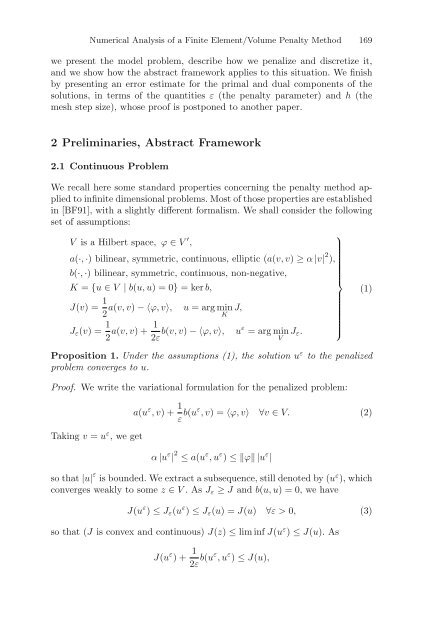Partial Differential Equations - Modelling and ... - ResearchGate
Partial Differential Equations - Modelling and ... - ResearchGate
Partial Differential Equations - Modelling and ... - ResearchGate
Create successful ePaper yourself
Turn your PDF publications into a flip-book with our unique Google optimized e-Paper software.
Numerical Analysis of a Finite Element/Volume Penalty Method 169<br />
we present the model problem, describe how we penalize <strong>and</strong> discretize it,<br />
<strong>and</strong> we show how the abstract framework applies to this situation. We finish<br />
by presenting an error estimate for the primal <strong>and</strong> dual components of the<br />
solutions, in terms of the quantities ε (the penalty parameter) <strong>and</strong> h (the<br />
mesh step size), whose proof is postponed to another paper.<br />
2 Preliminaries, Abstract Framework<br />
2.1 Continuous Problem<br />
We recall here some st<strong>and</strong>ard properties concerning the penalty method applied<br />
to infinite dimensional problems. Most of those properties are established<br />
in [BF91], with a slightly different formalism. We shall consider the following<br />
set of assumptions:<br />
⎫<br />
V is a Hilbert space, ϕ ∈ V ′ ,<br />
a(·, ·) bilinear, symmetric, continuous, elliptic (a(v, v) ≥ α |v| 2 ),<br />
b(·, ·) bilinear, symmetric, continuous, non-negative,<br />
⎪⎬<br />
K = {u ∈ V | b(u, u) =0} =kerb,<br />
(1)<br />
J(v) = 1 a(v, v) −〈ϕ, v〉,<br />
2 u<br />
=argmin<br />
K J,<br />
J ε (v) = 1 2 a(v, v)+ 1 b(v, v) −〈ϕ, v〉,<br />
2ε uε<br />
=argmin<br />
V J ε.<br />
⎪⎭<br />
Proposition 1. Under the assumptions (1), the solution u ε to the penalized<br />
problem converges to u.<br />
Proof. We write the variational formulation for the penalized problem:<br />
Taking v = u ε , we get<br />
a(u ε ,v)+ 1 ε b(uε ,v)=〈ϕ, v〉 ∀v ∈ V. (2)<br />
α |u ε | 2 ≤ a(u ε ,u ε ) ≤‖ϕ‖|u ε |<br />
so that |u| ε is bounded. We extract a subsequence, still denoted by (u ε ), which<br />
converges weakly to some z ∈ V .AsJ ε ≥ J <strong>and</strong> b(u, u) =0,wehave<br />
J(u ε ) ≤ J ε (u ε ) ≤ J ε (u) =J(u) ∀ε >0, (3)<br />
so that (J is convex <strong>and</strong> continuous) J(z) ≤ lim inf J(u ε ) ≤ J(u). As<br />
J(u ε )+ 1 2ε b(uε ,u ε ) ≤ J(u),
















